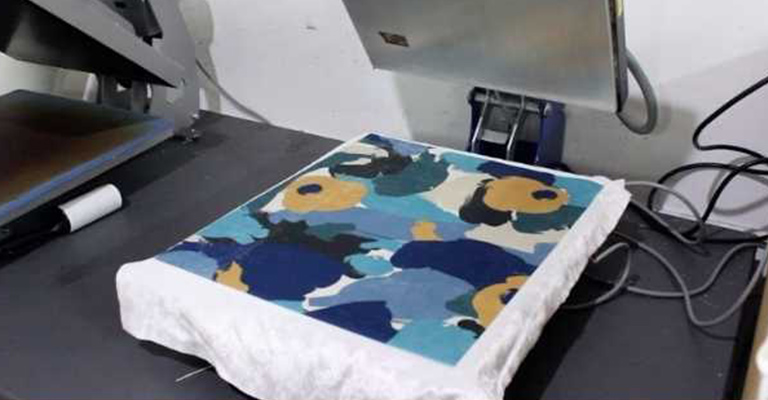You can sublimate on rayon, given that you follow proper procedures. Firstly, you have to apply desizer coating and polyester coating to the fabric. The polyester coating is applied on rayon as it is a synthetic fiber and fits best for sublimation printing.

Later you have to heat press the fabric dry and make the printed transfer. Finally, you can set the printed transfer with the help of butcher paper and heat press again to settle. Carefully remove the paper to get the result.
Can You Sublimate On Rayon
Sublimation printing is an efficient process that gives you professional graphics. Rayon is considered to be the best synthetic material for sublimation printing. It is also well known as one of the most popular substrates in the sublimation printing industry.
Therefore, you can indeed sublimate on rayon in addition to polyester. You can add polyester coating on rayon substrates to get the best results. Below are the steps to do it properly.
Step 1: Prepare the Desizer Solution and Polyester Solution
To get started, you have to prepare a desizer solution. Add 7 ounces of water for every 1 ounce of desizer concentrate. Mix them well and pour them into a spray bottle. Similarly, prepare a polyester solution as well.
Step 2: Spray the Desizer Solution
Next, apply the desizer solution spray everywhere on the fabric. You should make sure that the fabric feels wet and comfortable before proceeding to the next step.
Step 3: Heat Press the Nylon
After making sure that you have properly applied the spray, it is time to heat press the fabric. However, before applying the press, you have the nylon fabric covered with a thin and dry cloth. Even better if you can manage a cotton cloth because it will absorb the moisture better.
Set the heat press temperature at 385F and press it on the fabric for around 35 seconds carefully. As soon as you see the steam coming out, stop the pressing and start putting on the polyester coating.
Step 4: Spray the Polyester Coating
You are done with steaming the desizer. Now you have to apply the polyester coating to the image. Before that, make sure that the polyester coat coating area is within the designer area. You can make use of cardboard as a guide to creating spray borders. Then remove the cardboard and apply the coating further across the entire print area.
Step 5: Dry the Fabric
After you are done with spraying the polyester coating, fold the fabric and press it with your hand to let the coating sit. Right after that, unfold the fabric and let it dry.
Another option is to heat press if you want to dry it faster. You can simply hover the heat press over the underneath fabric instead of letting it touch the polyester coating. Continue doing so until it becomes dry.
Step 6: Apply Heat Press On the Fabric
In this particular step, you have to cover them with butcher paper at first. Then apply heat press on it for about 10 seconds and at 385F. With that, you are done with the first poly coat. Similarly, apply a second light coat and hover the heat press over it again to make it dry.
Step 7: Ready the Printed Transfer and Apply It
Once the second coat is dry, you have to cover it with butcher paper and heat press it again for 10 seconds. Now ready your printed transfer and put it on the pre-treated area of the nylon fabric. You can put a silicone mat underneath to help focus the heat. After that, carefully put the printed transfer and butcher paper over it and sublimate with a heat press at 385F for about 75 seconds.
Step 8: Remove the Butcher Paper
The last step is to remove the butcher paper after heat pressing is done. Transfer slowly from one corner to avoid any damage to the image. That is how you will be done sublimating on rayon.
Why Sublimation Printing Is Best for Rayon
As a synthetic material, rayon bends with materials like polyester or cotton. Therefore, when rayon is exposed to heat, the fiber of the material expands. As a consequence, a notable space is created in the thread. That area plays traps the dye molecules and gives birth to vivid printings.
When you apply high temperature, the dye molecules are converted into gaseous moles and get trapped in that space. The molecules stay there for a long time. This is due to the expanded fiber which makes the process a lot easier. Again when high pressure is applied, the dye molecules are converted into a solid state. At the same time, the thread contracts. This results in the molecules staying longer in the fiber.
Frequently Asked Questions
- What fabrics can you sublimate on?
Sublimation works best on garments that have polyester. It is also possible on other materials such as cotton. However, in the case of sublimating synthetic materials, the image will not be permanent if there is no polyester coating.
- Does rayon dry quickly?
Rayon indeed dries quickly. It can be heat-pressed to dry faster as well. Moreover, it is a wrinkle-resistant fabric that feels smooth on the skin.
Conclusion
The processes of sublimating on rayon may seem rather complicated, however, they are easy to implement once you get the hang of it. After getting used to it, you will be confident enough to make any printing design regardless of the complexity.
Leave a Reply